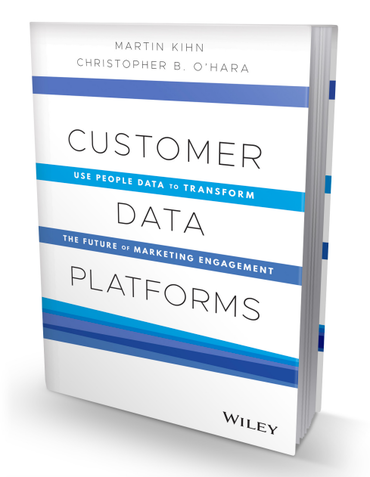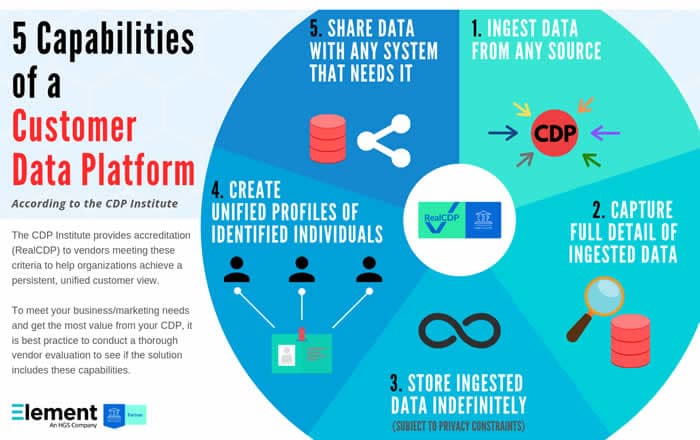The Salesforce 2020 State of Marketing research showed that Customer Data Platforms (CDPs) were among the highest priority investments for CMOs in 2021. The research found that customer data sets the stage for empathetic marketing. Seventy-eight percent of marketers describe their customer engagement as data-driven.
Special feature
Turning Big Data into Business Insights
Businesses are good at collecting data, and the Internet of Things is taking it to the next level. But, the most advanced organizations are using it to power digital transformation.
Read More
Chris O’Hara and Martin Kihn are co-authors of the book Customer Data Platforms. O’Hara is vice president of product marketing at Salesforce, and in his new book, he highlights how CDPs offer companies a way to capture, unify, activate, and analyze customer data. The promise of CDPs is to help companies deliver the “right person, right message, right time” experience.
Most of the customer data that marketers use is from transactional data. More and more marketers must improve their ability to better understand digital identities and the person’s engagement journey with a brand, before, during, and after a purchase. The median number of data sources used by marketers was eight in 2019, 10 in 2020, and 12 by 2021.
The challenge that marketers face today is delivering a consistent and personalized service to customers across multiple channels.
“When it comes to marketing, customers expect the interactions they have on a company’s website to translate to their mobile app experiences and even in-store visits. The problem is that, for most companies, those environments operate off of different datasets — even though the customer is the same. Customers also expect their experiences as they move from channel to channel to be consistent, and ‘in the moment.’ Most customer journeys involve over three different channels (e.g., email, web, and mobile app), and customers tend to move seamlessly and quickly between these channels. Most companies, however, don’t have these data environments connected in real-time. The result is disconnected experiences for consumers and the lack of a single source of truth about customers for the marketer,” writes O’Hara.


Customer Data Platforms: Use People Data to Transform the Future of Marketing Engagement, by Kihn and O’Hara
The basic benefits and primary tasks of CDPs are: Data collection, data unification, data activation, and data insights. I asked O’Hara to share his thoughts about what CDPs need to successfully deliver a better, faster, and more personalized customer experience. O’Hara’s perspective goes beyond marketing benefits. He believes that the right data management strategy, coupled with CDPs, can help deliver customer insights to the entire business, helping companies create value at the speed of need.
CDPs are the hottest marketing technology around today. The rise of the customer data platform has been interesting to watch. CDPs are an exciting new software category, and most progressive organizations are looking at them as a way of solving some fundamental business challenges: How do you get a “single source of truth” for customer data when customers create so much of them? Data, that is.
Endless advertising and marketing technology software acquisitions, patched together through brittle “data extensions” and manual integrations lead to many differing views of customers, mostly centered on what channel they are engaging on. Companies tend to have a “marketing” customer they can understand through interactions in email, an “advertising” customer they know through pseudonymous online interactions, and “sales” customers they understand by their profile in a CRM system. Connecting those identities into a rich profile can unlock a lot of value.
Imagine if the call center employee, for example, could have access to a rich profile of every customer that included her recent purchases, loyalty status and points, marketing interactions, and lifetime value score? You might be able to have a real, personalized interaction rather than reading from a canned call script. Imagine further, if the system was smart enough to assign an inbound call priority based on those data attributes, such that a “Platinum” loyalty member got routed to the local call center, rather than the overseas location? Better, more personalized, service. Less customer churn. The possibilities are endless!
The good news is that this is happening today. Large enterprises with sophisticated IT departments, in-house developers, and large software budgets are connecting these systems to create such results. The bad news is that it’s very expensive, requires constant vigilance and development to keep it working, and its dependent upon licensing solutions from dozens of software vendors for data ingestion to data activation, and everything in between.
The other problem is that this innovation seems to be aimed solely at marketing use cases today. Despite the fact that 80% of companies we surveyed in our State of Marketing Report say they have already begun to connect their marketing and service systems, today’s CDPs seem to be narrowly focused on marketing, advertising, and personalization use cases. But why stop data management there?
STATE of MARKETING:
1 top priorities
2 top challenges
3 top team skills
4 alignment with CIOs
5 top marketing technologies
6 adoption of new tech ML NLP CDP
7 data management success
8 AI marketing use cases
9 most important metrics
10 business goals https://t.co/sAYSmgjXil pic.twitter.com/EZN4b8Oy7y— Vala Afshar (@ValaAfshar) April 8, 2021
If you are embarking on a true data management journey and want some guideposts for building a system that can truly connect your entire enterprise at the data platform layer (where it counts), there are five critical things to think about:
Velocity
Your systems need to manage a high volume of data, coming in at various speeds. Some data, such as CRM and legacy enterprise system data is slower-moving and generally comes in via batch mode, in the form of tables. These are things like customer records, purchase history data, and the like. But there’s a lot of data that needs to come into the system in real-time. An online customer looking for a local store where they can apply an offer they received is information happening in real-time that can be applied to real-world use cases. Unless you can read and react to that signal quickly, they are likely to find the nearest competitor. So having a system that can handle data at many different speeds is a requirement, especially as more and more signals are created from real-time and real-life interactions.
Variety
You then need to map first-party data into a single information model. Data silos, as discussed above, are just the tip of the iceberg. It’s obvious that connecting marketing, advertising, and CRM systems can create new use cases that drive business value, but the true underlying issue isn’t the systems themselves, but how they store data. One system labels a first name and “First_Name” and another as “FirstName.” It seems trivial, but every system has a slightly different main identifier or “source of truth,” and the goal is to have one. This starts with being able to provision a universal information model, or schema, which can organize all of the differently labeled data into a common taxonomy. Companies are starting to organize around a Common Information Model (The “Cloud” Information Model for companies like Google, Amazon, and Salesforce) as a way of creating a Rosetta Stone for data.
Veracity
Companies must ensure they can provision a single, persistent profile for every customer or account. Social media systems think of your “handle” as your primary identifier. Email systems use the e-mail address. DMPs usually see people as cookies. Every system is somewhat different. How do you get a “single source of truth” for people data? All of these identity types need to roll up to a rich profile or universal ID. This gets resolved in “known” PII data by making sure one person is the same among many different e-mail and postal addresses, as an example. In the digital world, where people tend to have dozens of cookies and device IDs, these identifiers also need to be mapped to the universal ID. It’s a hard problem to solve, but a system that has a strong identity spine is the only way to get there.
Volume
Once you manage to resolve and identify data from many different sources and systems, you end up with… a lot of data. It has been theorized that, in 2020, 1.7MB of data was created every second for every person on Earth. That’s hard to fathom, but it’s a problem that is not going away in a world that increasingly values every click, call, and video view. If you want to use those interactions to form the basis of your digital engagement strategy, you have to store them somewhere. That necessitates a system that can handle billions of data attributes, millions of rows, and thousands of interconnected tables. Machine learning works best when pointed at petabytes of analytic data. Your system needs to be built for a world in which more data is created every day, and there are more systems that require them to work well.
Value
The real question is, how do you make data actionable in every channel — marketing, sales, service, commerce, and analytics — and get tangible value from them? Once you have a clean, unified set of scaled data there are many ways to derive value from it. Segmentation tools can pull data from any source and stitch it into scaled groups of addressable customers. Analytics tools get more powerful when analyzing a robust and comprehensive dataset whether for BI or media analytics. The best part? AI systems get more powerful. Success in machine learning is not about the algorithms, it’s about giving them the ability to run across a highly scaled, true, set of data that creates results.
If you are thinking about starting your company’s digital transformation journey with a CDP or an enterprise data management system, the five Vs are a great framework for success.
This article was co-authored by Chris O’Hara, vice president of global product marketing at Salesforce, and co-author of a new book Customer Data Platforms.



